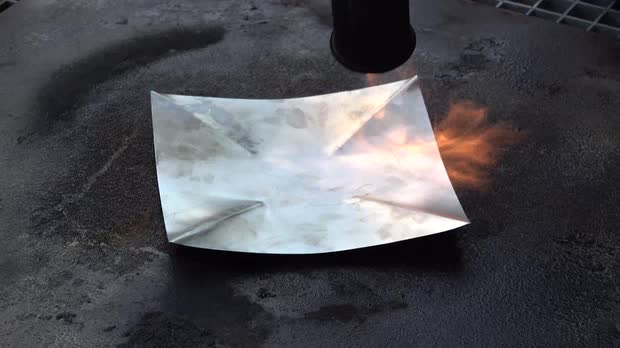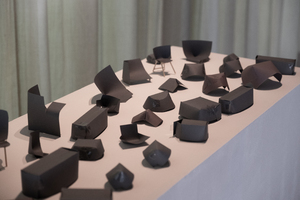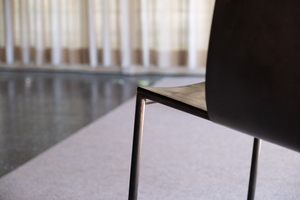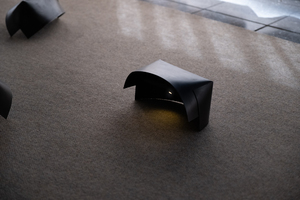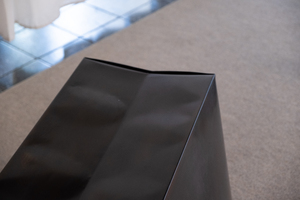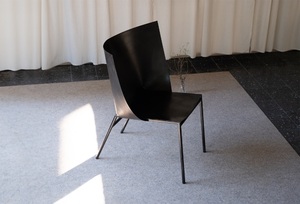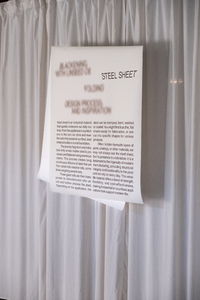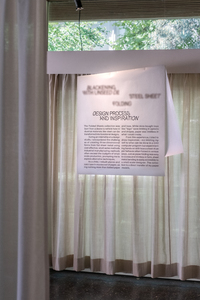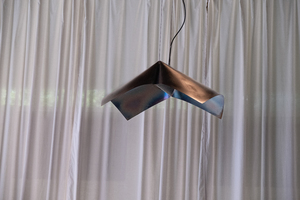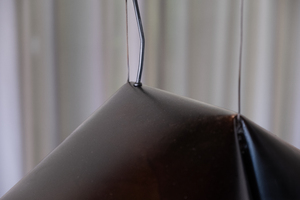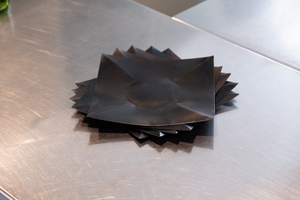Folded Sheets
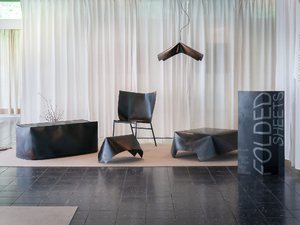
Folded Sheets
John Weber
| Fachgruppe |
22 Inhalte
- Seite 1 von 2
Schwarzbrenn prozess short
- Titel
- Schwarzbrenn prozess short
- Autor/in
- Datierung
- 2025
- Titel
- Schwarzbrenn prozess short
- Urheberrechtshinweis
- © John Weber
- Rechtsschutz/Lizenz
- Freigabe Nutzung HfG
- Medienersteller/in
- Beziehung/Funktion
- Medien-Beschreibung
- Um dem Stahlblech stabiler zu machen, und um es vor Korrosion zu schützen wird Leinöl aufgetragen und langsam eingebrannt.
Bei der hitze verdampft das Öl und hinterlässt eine schwarze Oxid Schicht.
- Um dem Stahlblech stabiler zu machen, und um es vor Korrosion zu schützen wird Leinöl aufgetragen und langsam eingebrannt.
- Projektleiter/in
- Studiengang
- Typ der Abschlussarbeit
- Importiert am
- 17.07.2025
- Übergeordnete Sets
- 1
Folded Sheets/ Paper Models
- Titel
- Folded Sheets/ Paper Models
- Autor/in
- Datierung
- 2025
- Titel
- Folded Sheets/ Paper Models
- Urheberrechtshinweis
- © John Weber
- Freigabe Nutzung HfG
- Medienersteller/in
- Beziehung/Funktion
- Medien-Beschreibung
- Paper Models
- Medien-Beschreibung (en)
- As a child, I rebuilt planes and cars I saw in movies using just folded paper and tape. Unlike store-bought toys like LEGO, paper gave me endless freedom to create any shape I imagined.
From this experience, I tried to draw inspiration—not limiting myself to what can be done in aCAD computer program but experimenting hands-on with how a sheet of paper behaves whenfolded in various ways.
To avoid using heavy industrial machines to form steel sheets, I explored different paper-folding techniques. My goal was to develop a kind of folding language I could later apply to steel, allowing me to work intuitively and efficiently.
After testing many shapes, I focused on a few that worked well and refined them further, building 1:10 scale models to better understand and improve the designs.
By using only rectangular sheets, I could reduce material waste and improve recyclability. Folded and bent shapes often result in surprisingly strong and stable objects.
- As a child, I rebuilt planes and cars I saw in movies using just folded paper and tape. Unlike store-bought toys like LEGO, paper gave me endless freedom to create any shape I imagined.
- Projektleiter/in
- Studiengang
- Typ der Abschlussarbeit
- Importiert am
- 15.07.2025
- Übergeordnete Sets
- 1
Folded Sheets/ Chair
- Titel
- Folded Sheets/ Chair
- Autor/in
- Schlagworte
- Datierung
- 2025
- Titel
- Folded Sheets/ Chair
- Urheberrechtshinweis
- © John Weber
- Rechtsschutz/Lizenz
- Freigabe Nutzung HfG
- Medienersteller/in
- Medien-Beschreibung (en)
- The folded Chair from my Diploma collection ”Folded Sheets“ uses a rectangular steel
sheet to create a comfortable chair shell. The sheet it cut and folded to wrap around the
frame and create a round shell like shape under tension. This tension makes for a comfort-
able round shape that slightly leans back as you press your back into it. The shell and the
frame hold together by tension. No screws used, only the tension of the steel sheet.
- The folded Chair from my Diploma collection ”Folded Sheets“ uses a rectangular steel
- Projektleiter/in
- Studiengang
- Typ der Abschlussarbeit
- Importiert am
- 15.07.2025
- Übergeordnete Sets
- 1
Folded Sheets/ Shell
- Titel
- Folded Sheets/ Shell
- Autor/in
- Schlagworte
- Datierung
- 2025
- Titel
- Folded Sheets/ Shell
- Urheberrechtshinweis
- © John Weber
- Rechtsschutz/Lizenz
- Freigabe Nutzung HfG
- Medienersteller/in
- Projektleiter/in
- Studiengang
- Typ der Abschlussarbeit
- Importiert am
- 15.07.2025
- Übergeordnete Sets
- 1
Folded Sheets/ Bench
- Titel
- Folded Sheets/ Bench
- Autor/in
- Schlagworte
- Datierung
- 2025
- Titel
- Folded Sheets/ Bench
- Urheberrechtshinweis
- © John Weber
- Rechtsschutz/Lizenz
- Freigabe Nutzung HfG
- Medienersteller/in
- Medien-Beschreibung (en)
- The bench is a blend of two steel sheet folding techniques. The top surface is expertly brake-formed, creating three distinct folds that not only ensure a comfortable seating area but also allow the rectangular seating surface to curve gracefully towards the ground. This design is further enhanced by a strategic cut and slide method, which introduces tension to the bench's feet and contributes to its rounded base.
A central crease in the seating surface adds stability and serves as a water drainage channel on both sides. The rounded shape allows the bench to rest on the ground only at its two sides, with the front and back elegantly curving upwards. This design lends the entire structure a lighter, more dynamic feel, making it both functional and aesthetically pleasing.
- The bench is a blend of two steel sheet folding techniques. The top surface is expertly brake-formed, creating three distinct folds that not only ensure a comfortable seating area but also allow the rectangular seating surface to curve gracefully towards the ground. This design is further enhanced by a strategic cut and slide method, which introduces tension to the bench's feet and contributes to its rounded base.
- Projektleiter/in
- Studiengang
- Typ der Abschlussarbeit
- Importiert am
- 15.07.2025
- Übergeordnete Sets
- 1
Folded Sheets
- Titel
- Folded Sheets
- Autor/in
- Schlagworte
- Datierung
- 2025
- Titel
- Folded Sheets
- Urheberrechtshinweis
- © John Weber
- Rechtsschutz/Lizenz
- Freigabe Nutzung HfG
- Medienersteller/in
- Projektleiter/in
- Studiengang
- Typ der Abschlussarbeit
- Importiert am
- 15.07.2025
- Übergeordnete Sets
- 1
Folded Sheets/ Chair
- Titel
- Folded Sheets/ Chair
- Autor/in
- Schlagworte
- Datierung
- 2025
- Titel
- Folded Sheets/ Chair
- Urheberrechtshinweis
- © John Weber
- Rechtsschutz/Lizenz
- Freigabe Nutzung HfG
- Medienersteller/in
- Medien-Beschreibung (en)
- The folded Chair from my Diploma collection ”Folded Sheets“ uses a rectangular steel
sheet to create a comfortable chair shell. The sheet it cut and folded to wrap around the
frame and create a round shell like shape under tension. This tension makes for a comfort-
able round shape that slightly leans back as you press your back into it. The shell and the
frame hold together by tension. No screws used, only the tension of the steel sheet.
- The folded Chair from my Diploma collection ”Folded Sheets“ uses a rectangular steel
- Projektleiter/in
- Studiengang
- Typ der Abschlussarbeit
- Importiert am
- 15.07.2025
- Übergeordnete Sets
- 1
Folded Sheets/ Infopanels
- Titel
- Folded Sheets/ Infopanels
- Autor/in
- Schlagworte
- Datierung
- 2025
- Titel
- Folded Sheets/ Infopanels
- Urheberrechtshinweis
- © John Weber
- Rechtsschutz/Lizenz
- Freigabe Nutzung HfG
- Medienersteller/in
- Medien-Beschreibung (en)
- The narrative of this exhivition was displayed on three folded paper info panels. Paper was folded on a thin rope.
- The narrative of this exhivition was displayed on three folded paper info panels. Paper was folded on a thin rope.
- Projektleiter/in
- Studiengang
- Typ der Abschlussarbeit
- Importiert am
- 15.07.2025
- Übergeordnete Sets
- 1
Folded Sheets/ Infopanels
- Titel
- Folded Sheets/ Infopanels
- Autor/in
- Schlagworte
- Datierung
- 2025
- Titel
- Folded Sheets/ Infopanels
- Urheberrechtshinweis
- © John Weber
- Rechtsschutz/Lizenz
- Freigabe Nutzung HfG
- Medienersteller/in
- Medien-Beschreibung (en)
- The narrative of this exhivition was displayed on three folded paper info panels. Paper was folded on a thin rope.
- The narrative of this exhivition was displayed on three folded paper info panels. Paper was folded on a thin rope.
- Projektleiter/in
- Studiengang
- Typ der Abschlussarbeit
- Importiert am
- 15.07.2025
- Übergeordnete Sets
- 1
Folded Sheets/ Pendant Lamp
- Titel
- Folded Sheets/ Pendant Lamp
- Autor/in
- Schlagworte
- Datierung
- 2025
- Titel
- Folded Sheets/ Pendant Lamp
- Urheberrechtshinweis
- © John Weber
- Rechtsschutz/Lizenz
- Freigabe Nutzung HfG
- Medienersteller/in
- Medien-Beschreibung (en)
- Pendant Lamp uses inward folds to tension the flat sheet into a convex shape. The inward folds hold tight a steel wire, used to hang the obejct into the air. Recessed LEDs light the inside of the Lamp, showcasing the volume created by tension.
- Projektleiter/in
- Studiengang
- Typ der Abschlussarbeit
- Importiert am
- 15.07.2025
- Übergeordnete Sets
- 1
Folded Sheets/ Pendant Lamp
- Titel
- Folded Sheets/ Pendant Lamp
- Autor/in
- Schlagworte
- Datierung
- 2025
- Titel
- Folded Sheets/ Pendant Lamp
- Urheberrechtshinweis
- © John Weber
- Rechtsschutz/Lizenz
- Freigabe Nutzung HfG
- Medienersteller/in
- Medien-Beschreibung (en)
- Pendant Lamp uses inward folds to tension the flat sheet into a convex shape. The inward folds hold tight a steel wire, used to hang the obejct into the air. Recessed LEDs light the inside of the Lamp, showcasing the volume created by tension.
- Projektleiter/in
- Studiengang
- Typ der Abschlussarbeit
- Importiert am
- 15.07.2025
- Übergeordnete Sets
- 1
Folded Sheets/ Plates
- Titel
- Folded Sheets/ Plates
- Autor/in
- Schlagworte
- Datierung
- 2025
- Titel
- Folded Sheets/ Plates
- Urheberrechtshinweis
- © John Weber
- Rechtsschutz/Lizenz
- Freigabe Nutzung HfG
- Medienersteller/in
- Medien-Beschreibung (en)
- The "Frosch" is a phenomenon in sheet metal processing where tension is created in the material through deformation. By applying force against this tension, the sheet metal "springs" back with an audible snap into an opposite shape. The plate series utilizes this effect to create a concave form that serves as a plate or bowl.
- Projektleiter/in
- Studiengang
- Typ der Abschlussarbeit
- Importiert am
- 15.07.2025
- Übergeordnete Sets
- 1
